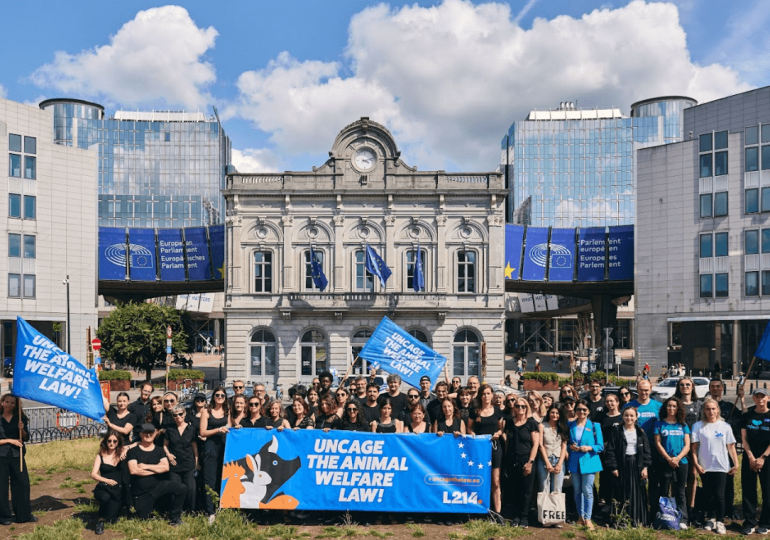This is a guest blog post. All opinions are that of the guest blogger.
In our previous post, we examined why European Union animal welfare reform has stalled despite overwhelming public support. Now, let’s explore how advocates can overcome these obstacles and achieve meaningful change.
The animal advocacy movement must evolve to break through legislative gridlock. This requires focusing on four key areas: strengthening the movement itself, implementing innovative tools and tactics, enhancing political representation, and unlocking new opportunities.
1. Strengthening the Animal Advocacy Movement
Strengthening the structure of the animal advocacy movement is crucial for achieving lasting political impact. This begins with mobilizing greater funding dedicated explicitly to political advocacy. Cross-border collaboration among E.U. member states should also be prioritized, allowing organizations to share resources, strategies, and best practices while reducing internal fragmentation and counterproductive competition.
Image: Joint protest outside the European Parliament to demand that the E.U. deliver an ambitious revision of the animal welfare legislation. Credit: Camille Martins / L214.
A paradigm shift is needed within the animal movement to embrace cooperation and gain awareness of movement ecology: understanding that diverse stakeholders with various functions, locations, and approaches are all necessary to shape a strong, agile, and resilient movement. Political victories at the E.U. level will be shared, not only within the E.U. but also internationally.
Just as important as financial and structural support is a cultural shift toward deeper politicization. Protecting animals is not just an individual issue but a matter of justice; political decisions de facto shape the fate of animals in our societies. This shift should involve creating forums for strategic discussion, whether virtual or at in-person conferences. Strategic funding should not only support high-level lobbying efforts but also grassroots mobilization, ensuring that political pressure is applied by citizens themselves.
Lastly, advocacy efforts must be timed appropriately: Political victories need continuous preparation in order to seize opportunities effectively.
2. Implementing New Tools and Tactics
Adopting innovative tools and strategies can help expand the animal advocacy movement’s political reach. This includes crafting narratives that resonate across the political spectrum by linking animal welfare to pressing societal concerns such as food safety, inflation, and global health. Reminding others of the advantages of animal welfare reforms can help build broader and more durable support. As every claim must be supported by scientific evidence, a thorough and collaborative research effort must be carried out.
With the upcoming proposal for the next Common Agricultural Policy (CAP) covering the period 2028–2034, the animal advocacy movement faces another key opportunity to influence European agricultural reform. The CAP, which allocates a substantial portion of the E.U. budget, has the potential to become a powerful tool for driving improvements in animal welfare. Redirecting subsidies to improve animal welfare standards would mean a shift from intensive, industrial practices to more humane farming systems. To achieve this, engaging early in the policy process will be essential to ensure the inclusion of conditionality mechanisms (incentives that reward progressive farmers), targeted funding, and incentives that reward progressive farmers.
3. Strengthening the Political Representation of Animals
Improving how animals are represented politically within the E.U., both formally and informally, is a necessary structural investment, with the potential to support progress over time. Monitoring and publishing policymakers’ decisions, voting records, and public statements will enhance transparency and empower citizens to hold leaders accountable. Moreover, new institutional roles, such as the E.U. Commissioner for Health and Animal Welfare, combined with stronger direct democracy tools like the European Citizens InitiativeI, present a significant opportunity to address the historic neglect of animal interests in E.U. policy. Together, they can bridge the gap between political promises and practical outcomes, ensuring that animal welfare is not only recognized in principle but also advanced through concrete, effective action at the European level.
Image: Animal advocate symbolically voting to support the revision of the E.U. Animal Welfare Legislation. Credit Camille Martins / L214.
4. Unlocking New Opportunities
To unlock new opportunities, the movement should expand its political leverage by building alliances across the political spectrum. In parallel, strengthening media engagement through strategic use of digital platforms and targeted PR campaigns can amplify advocacy efforts and combat disinformation to keep animal welfare high on the public agenda.
The movement should also pursue strategic partnerships with small-scale farmers and their representatives—particularly those open to more responsible production models. Aligning on goals such as sustainable agriculture and fair market access can strengthen collaboration and contribute to a broader coalition, supporting reforms that advance both animal welfare and the small-scale farming sector.
Next steps
The European Commission and the European Parliament are more conservative than they were four years ago. A new legislative cycle is now starting for animal advocates in Europe. The stakes are massive: The future of farmed animals, environmental sustainability, public health, and democratic accountability is on the line. And yet, the opportunity gives us much hope for significant progress. While recent disappointments have exposed institutional inertia and the strength of opposing lobbies, they have also clarified the road ahead.
The challenges we now face are numerous, ranging from political resistance and industry backlash to media narratives and legislative gridlock—but they are not insurmountable. With an ambitious vision for the future and a pragmatic approach, we can move forward with a sharpened strategy. We can move forward with a sharpened strategy.
Now more than ever, the movement should remain united to end cages in Europe and alleviate the suffering of billions of animals.
Leave a comment






